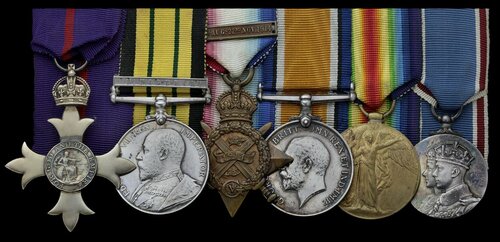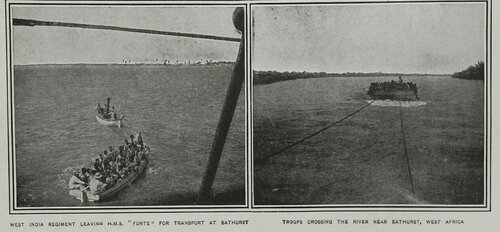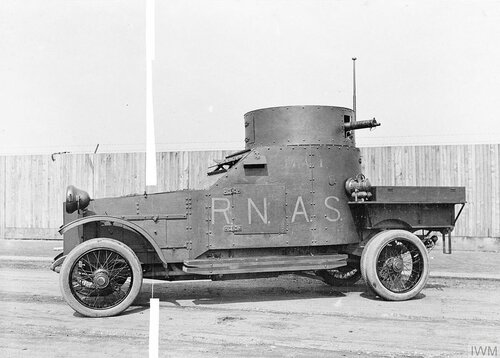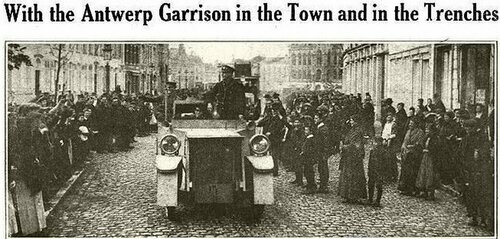Auction: 22001 - Orders, Decorations and Medals
Lot: 380
'They were sailors and adventurers by tradition; they adapted themselves to circumstance, and made the best of what they found. Their courage put new heart into desperate men, and their humanity (the greatest tradition of the British Navy) added lustre to their courage.'
The War in the Air, Volume I, refers.
The stunning 'Motor Bandits' O.B.E. group of six awarded to Major C. F. O. Graham, Royal Marines and West African Frontier Force, the founder of The Gambia Company, later Gambia Regiment, who was 'mentioned' for his North Nigeria Service before acting as Second-in-Command of the Royal Marine Brigade's reinforcements to the Armoured Car Section in France, soon to earn the name the 'Motor Bandits'
The Most Excellent Order of the British Empire, 1st Type Officer's breast Badge, Military Division, silver-gilt, hallmarks for London 1919; Africa General Service 1902-56, 1 clasp, N. Nigeria (Capt: C. F. O. Graham, N. Nigeria Rgt:); 1914 Star, with clasp (Captain. C. F. O. Graham, R.M. Attached. R.N.A.S.); British War and Victory Medals (Maj. C. F. G. Graham. R.M.); Coronation 1937, mounted as worn, pitting and edge wear, overall very fine (6)
One of the five original officers to serve with the Royal Marine detachment in this unit.
O.B.E. London Gazette 16 September 1919.
Charles Frederick Oliver Graham was born at Kingston, Jamaica on 12 September 1877, the son of Susan and Lieutenant-Colonel Lionel Frederic Graham, Ordinance Department. Following his father into the military the young Graham was commissioned into the Royal Marines as a 2nd Lieutenant on 1 January 1896. After a year at the Royal Naval College he was posted to the Chatham Division on 1 January 1897 with the rank of Lieutenant. Transferred to his first posting afloat on 18 December 1897 Graham served aboard H.M.S. Jupiter in the Channel before moving to H.M.S. Cambridge, the Royal Naval Gunnery School off Plymouth on 18 August 1898. Graham's first major action came the next year when on 3 June 1899 he was seconded to the West African Frontier Force with the local rank of Captain. Here he led a company under Colonel G. V. Kemball in North Nigeria for the expeditions against the Emirs of Bida and Kontagora in January and February 1901, receiving a 'mention' in the report of Governor Sir Frederick Lugard. In the aftermath of these actions Graham was appointed a Justice of the Peace for a District in Northern Nigeria on 11 September 1900. It was perhaps this experience which led to his next appointment in the Gambia and his first independent command.
Seeing resistance to Colonial rule in the late 1890s the British sought to centralise their military presence in West Africa with the creation of the West African Frontier Force. This formation was largely raised out of local Constabulary units with training from British Officers and NCOs. However in The Gambia there was no such Constabulary making the raising of a local unit extremely difficult, indeed it was not until 1900 that the creation of a local unit was contemplated. Graham was selected as the man to lead this force on 30 November 1901 with three other Officers and two NCOs to help him he landed at Bathurst in December 1901. As the British had only recently consolidated their control of Gambia they struggled to find willing recruits for the Company and by 31 December 1901 the number of men in training was only 30. This, combined with an uncertainly over the loyalty of local recruits, left Graham reliant on men drafted from the proven Serria Leone Battalion; although the men available were themselves largely untrained. The Company reached its full strength of 120 men by 2 February 1902.
The first action of the Gambia Company occurred on 16 April 1902 when the Governor, Sir George Denton, led a force against the Bita District. The Company supplied two officers (including Graham), a British NCO and 60 men supported by a maxim gun, this force supplemented a company of the West Indies Regiment. The expedition was a success as they toured the area, collecting taxes, settling disputes and putting down any resistance they encountered. With this success recognition for the unit grew and in June of that year they were recognised as a separate formation to the Serria Leone Battalion within the West African Field Force. Graham's role within the Colony grew along with his command as he was appointed a Commissioner to the Court of Requests for the Colony of Gambia on 18 July 1902. The one black mark against the Company record was the Gambia Mutiny which broke out in December 1902. A dispute over pay which grew into a minor mutiny, this was fortunately swiftly put down, although three men were imprisoned and the Company Sergeant-Major was demoted to Sergeant. With the Mutiny dealt with the unit was set back to training and was called upon again in November 1904 to aid in the punishment of a chief at Fogi who was sheltering a murderer. Graham commanded the expedition alongside the Governor, they proved immensely successful, largely due to the speed with which he was able to deploy his men; causing flight were there might have been resistance and burning five stockades. The Company was proving extremely effective by 1906, a fact Graham himself attributed to the improvements among the local NCOs, stating:
'I am finding that generally speaking, the NCOs are beginning to have a more real authority and in consequence I am beginning to feel that I can entrust them with work and responsibility which some time ago I would only have entrusted to a European.'
That same year his secondment ended, but Graham must have felt some pride at the effectiveness of the force he had created. Doubtless this only increased over time as the unit's battle honours grew and it advanced from a single company to The Gambia Regiment. Returning to Britain, Graham re-joined Chatham Division on 20 November 1906, remaining ashore until 4 January 1908 when he was posted to 4th Cruiser Squadron aboard H.M.S. Hogue. Later seeing service aboard H.M.S. Aboukir from 9 March 1909 in the Mediterranean, both ships were later to be destroyed in the same action on 22 September 1914. Graham was sent to the reserve of officers at his own request on 1 January 1910.
Recalled for duty on 1 August 1914 with the outbreak of the Great War, Graham was employed for first fortnight of the conflict as an Assistant Wartime Censor. It is possible to imagine his relief at escaping the Censor's office at North Foreland for a post at Portsmouth Division on 17 August 1914. Transferred from here to the Royal Marine Brigade on 30 September 1914, entering the war in France with the 'Motor Bandits' around the same time. Graham commanded the section sent to Antwerp with orders to guard Winston Churchill who arrived in the city on 3 October, Royal Marines in the War of 1914-1919, takes up the story stating:
'Captain Graham with his section of cars was detailed to escort Mr. Churchill into Antwerp on 3rd, but as the orders did not reach them in time, Mr. Churchill went into Antwerp by aeroplane. Captain Graham's section arrived in Antwerp that evening, being the first British troops to arrive; this section acted as escort to the First Lord during the Antwerp operations, but were left very much to themselves, they however, escorted him out of Antwerp for about 20 miles and then returned.'
They remained in Belgium, withdrawing slowly before the German advance, even leaving Ostend the same day that German forces occupied the city. Graham soon found himself commanding half of the unit at Dunkirk. Posted to Poperinghe on 16 October with three cars he was sent to reconnoitre the enemy and make contact with their cavalry which was performing the same role along the Menin-Roulers road. This they did resulting in a skirmish on 18 October which left two men dead. The unit was able to recover their bodies however by the method of reversing their cars to the dead men with the rear compartments soaking up the oncoming fire. They made their escape quickly with their companion's bodies, having called in an artillery bombardment upon the enemy. Graham's commander at the time, Commander C. R. Sampson, had this to say about the Marine officers under his command:
'The other Marine officers were Captains Graham, Lathbury, Coode and Williams; they were all first-class fighting men, keen and energetic.'
Leaving France on 3 November for Gallipoli Graham arrived at Port Said on 1 April. It was originally intended that they should join the fighting in the Dardanelles in their cars however it was soon realised that the ground was not commensurate with their deployment. Instead Graham went with Chatham Battalion, landing at ANZAC beach on 28 April 1915 along with Portsmouth Battalion. They went into action almost at once, relieving the Australian Brigades at McLaurin's Hill and Lone Pine Plateau. They remained in this position when on 30 April a major attack developed through Wire Gully, this had proved to be a weak point in the line as it was heavily exposed to enemy machine gun fire. An evening attack starting at 17:00 on 'B' Company managed to drive them from their positions with the Company commander Captain Hatton being killed in the fighting. Graham was commanding 'D' Company in the reserve at this point and immediately led them up the hill and into the line in support diving the enemy back and re-occupying the trench line. Just days later on 2 May an attempt was made to improve matters in the Monash Valley were Turkish positions overlooked the Australian lines. The Marines of Chatham and Portsmouth Battalions were sent to try and relieve the pressure on these positions. Graham was wounded during the relief by a gunshot wound to the knee with damaged his Tibia which inevitably saw him invalided on H.M.H.S. Ceramic and admitted to Plymouth Hospital on 7 August. Despite the seriousness of his wound Graham was not an exceptional case here, of the 30 officers who had arrived between 25-29 April 1915 28 were killed or injured, a casualty rate of 93 percent.
Appointed to the Staff of Admiral Meux, the Commander-in-Chief of Portsmouth upon his recovery. Promoted Major on 19 February 1916 he was later appointed to command No. '2' Company Headquarters Royal Marine Engineers on 6 April 1918. For this work he was based at Bedenham (Gosport) working upon shore defences. He may have performed this role overseas as well, given that during this time he received the thanks of the Commander-in-Chief Mediterranean for a valuable report on the coastal defences of Savona, Italy. Graham remained in this role until the end of the war, returning again to the Reserve of Officers on 30 September 1919.
Despite his years of service Graham was to be called to service once more in his career, during the Coal Miners' Strike on 8 April 1921. It may have been this experience which awakened a political instinct within him as he stood as a Councillor at Gosport in November 1922. Graham was a Freemason, having been initiated on 11 December 1906 and went on to found St. Swithin's Lodge in Gosport, Hampshire on 4 November 1925. Elected Mayor of Gosport in November 1936 he was in office during the coronation in 1937 and for three years after that. Never one to put his duties down lightly Graham died in office on 1 May 1940, he is commemorated at Portsmouth Cathedral; sold together with an archive of original and copied research including:
i) Typed Biographic notes.
ii) Naval lists and Who's Who entries.
iii) Extracts from histories relating to the West African Frontier Force and 'Motor Bandits'.
iv) Service Records.
v) London Gazette entries.
vi) Statement of War Service.
vii) War Diaries for the Royal Marine Brigade.
viii) An extract from the Royal Marines in the 1921 Coal Strike.
xi) Obituaries.
x) Original photographs of Portsmouth Cathedral including the memorial to the recipient.
Subject to 20% VAT on Buyer’s Premium. For more information please view Terms and Conditions for Buyers.
Sold for
£2,400
Starting price
£1200











